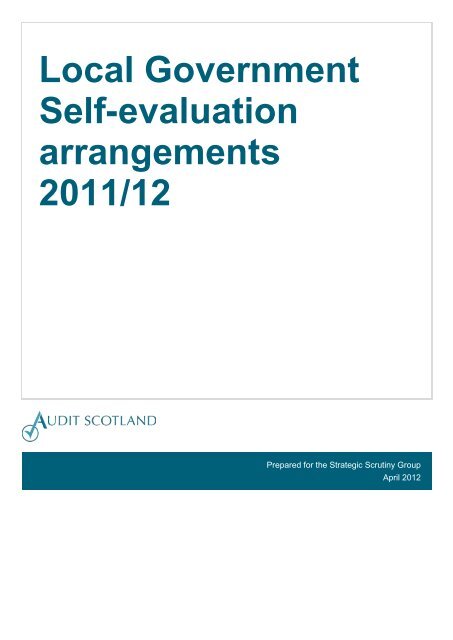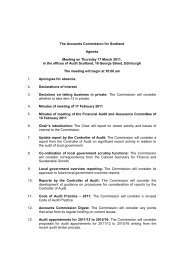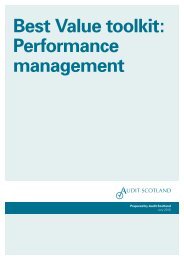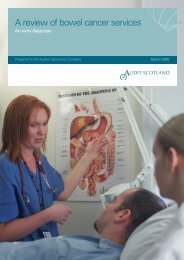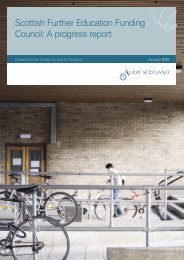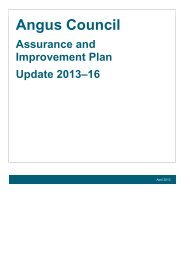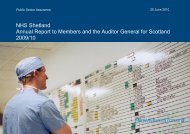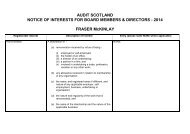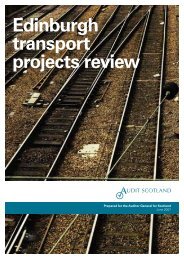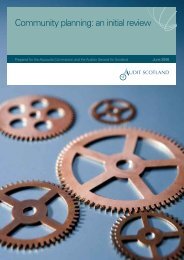Local Government self-evaluation arrangements ... - Audit Scotland
Local Government self-evaluation arrangements ... - Audit Scotland
Local Government self-evaluation arrangements ... - Audit Scotland
You also want an ePaper? Increase the reach of your titles
YUMPU automatically turns print PDFs into web optimized ePapers that Google loves.
<strong>Local</strong> <strong>Government</strong>Self-<strong>evaluation</strong><strong>arrangements</strong>2011/12Prepared for the Strategic Scrutiny GroupApril 2012
<strong>Audit</strong> <strong>Scotland</strong> is a statutory body set up in April 2000 under the Public Finance and Accountability(<strong>Scotland</strong>) Act 2000. It provides services to the <strong>Audit</strong>or General for <strong>Scotland</strong> and the AccountsCommission. Together they ensure that the Scottish <strong>Government</strong> and public sector bodies in<strong>Scotland</strong> are held to account for the proper, efficient and effective use of public funds.
ContentsIntroduction ................................................................................................................................... 4Self <strong>evaluation</strong> and proportionate and risk-based scrutiny ................................................. 4Review approach and objectives ....................................................................................... 5Findings ......................................................................................................................................... 6Corporate <strong>evaluation</strong> ......................................................................................................... 6Departmental or service-based <strong>self</strong>-<strong>evaluation</strong> .................................................................. 8Police and Fire ............................................................................................................................ 12Police .............................................................................................................................. 12Fire and rescue services ................................................................................................. 13Conclusions ................................................................................................................................ 14Appendix 1 .................................................................................................................................. 15Self-assessment checklist ............................................................................................... 15Appendix 2 .................................................................................................................................. 18Council Summaries ......................................................................................................... 18<strong>Local</strong> <strong>Government</strong> Self-<strong>evaluation</strong> <strong>arrangements</strong> 2011/12 Page 3
IntroductionIntroductionSelf <strong>evaluation</strong> and proportionate and risk-based scrutiny1. Developing effective <strong>self</strong>-<strong>evaluation</strong> is consistent with the Scottish Parliament’s 2007 reportIndependent Review of Regulation, <strong>Audit</strong>, Inspection and Complaints Handling of PublicServices in <strong>Scotland</strong> (The Crerar report), which recommended that the degree of futureexternal scrutiny should be dependent upon the range and quality of performancemanagement and associated <strong>self</strong>-assessment in place within public services.2. Rigorous <strong>self</strong>-<strong>evaluation</strong> and targeted scrutiny are tools that help public bodies to deliver theircommitment to improving services. They can provide important assurance to the Scottish<strong>Government</strong>, citizens and service users that public sector bodies are working well to deliveroutcomes for communities and citizens. This is generally reflected in public sector audit andinspection reports, which have commonly highlighted that those public bodies that are most<strong>self</strong>-aware of their strengths and weaknesses and act upon that knowledge, tend to be betterperformers.3. The Crerar report makes it clear that organisations need to take much greater responsibilityfor <strong>self</strong>-<strong>evaluation</strong> before external scrutiny can be minimised. External scrutiny can be acatalyst for improvement in the way that services are delivered where it influences behavioursand the culture of service providers. However, the primary responsibility for improvingservices lies with the organisations that provide them. Therefore, fundamental to anyreduction in scrutiny is the requirement for them to take greater responsibility for <strong>self</strong><strong>evaluation</strong>of service performance.4. <strong>Local</strong> authorities that carry out robust and reliable <strong>self</strong>-<strong>evaluation</strong> to improve their corporateprocesses, service performance and outcomes for citizens and users are likely to havedetailed, accurate, up-to-date and verifiable information that will allow scrutiny bodies toeffectively assess risk and target scrutiny activity to where it is most necessary.5. Following publication of the Crerar report, the Scottish <strong>Government</strong> established a ReducingBurdens Action Group (RBAG), which comprised senior representatives from localgovernment and scrutiny bodies. In September 2008, RBAG reported to ministers on practicalways of reducing the burden of scrutiny on public bodies, particularly at a strategic orcorporate level. To deliver this, RBAG recommended a new approach to scrutiny, with moreconsistent and robust <strong>self</strong>-<strong>evaluation</strong> at its very centre. A copy of its report is available athttp://www.scotland.gov.uk/Topics/<strong>Government</strong>/PublicServiceReform/IndependentReviewofReg/ActionGroups/RBAGFinal6. The recommendations from the RBAG also influenced the approach adopted by localgovernment scrutiny bodies to the shared risk assessment process. The SRA process hasreviewed and where appropriate placed reliance on councils' <strong>self</strong>-<strong>evaluation</strong> evidence whendetermining local scrutiny risks and related audit and inspection responses. Commentary oncouncils’ <strong>self</strong>-<strong>evaluation</strong> <strong>arrangements</strong> has also featured in Shared Risk Assessments (SRAs)Page 4 <strong>Local</strong> <strong>Government</strong> Self-<strong>evaluation</strong> <strong>arrangements</strong> 2011/12
Introductionand Assurance and Improvement Plans (AIPs). The overall assessment of uneven progressin delivering <strong>self</strong> <strong>evaluation</strong> across <strong>Scotland</strong>’s 32 councils was summarised in the NationalScrutiny Plan for <strong>Local</strong> <strong>Government</strong> 2011/12 (Exhibit 1).Exhibit 1Self-<strong>evaluation</strong> in Scottish CouncilsThere is commitment to developing robust <strong>self</strong>-<strong>evaluation</strong> <strong>arrangements</strong> as isevidenced, for example, by the increase in assisted <strong>self</strong>-<strong>evaluation</strong> activity and workbeing undertaken in partnership with the Improvement Service, and steady progress isbeing made in this area.However, inconsistencies in coverage and the quality of information across services,outcome areas and corporate processes are still apparent and it will take time before allcouncils have fully effective <strong>self</strong>-<strong>evaluation</strong> <strong>arrangements</strong> in place. In particular, the useof benchmarking data to assess costs, quality and performance remainsunderdeveloped in many places and service user views and customer satisfactioninformation also remains a continuing gap in existing information in many councils.Source: National Scrutiny Plan for <strong>Local</strong> <strong>Government</strong> 2011/12 (edited)Review approach and objectives7. Due to the evolving nature of <strong>self</strong> <strong>evaluation</strong> <strong>arrangements</strong>, it was agreed by the localgovernment scrutiny operational group, that this year <strong>Audit</strong> <strong>Scotland</strong> would gather data from<strong>Scotland</strong>’s 32 councils on:<strong>self</strong>-<strong>evaluation</strong> models, if any, adopted corporately by councils;how widespread <strong>self</strong>-<strong>evaluation</strong> is being used within councils; andany other, service-specific <strong>self</strong>-<strong>evaluation</strong> activity taking place within service departments.8. In August 2011, a <strong>self</strong>-<strong>evaluation</strong> audit checklist was distributed to all local governmentappointed auditors to map the level and range of <strong>self</strong>-<strong>evaluation</strong> activity taking place withintheir local authority (a copy of the checklist is shown in Appendix 1). Where local authoritiesare audited by our <strong>Audit</strong> Services Group (ASG), the checklist was completed by ASG staff.For those local authorities audited by private sector firms, the checklist was completed by staffin <strong>Audit</strong> <strong>Scotland</strong>’s Best Value and Scrutiny Improvement Group. Our findings are based onthe 32 completed checklists.9. The purpose of this exercise has been to capture factual information on the range and scopeof current <strong>self</strong> <strong>evaluation</strong> activity, rather than form a judgement on the effectiveness ofindividual councils’ <strong>self</strong> <strong>evaluation</strong> <strong>arrangements</strong> in supporting continuous improvement.Consideration may be given to carrying out a further exercise to assess the effectiveness ofindividual local authorities’ <strong>self</strong>-<strong>evaluation</strong> <strong>arrangements</strong> in future.<strong>Local</strong> <strong>Government</strong> Self-<strong>evaluation</strong> <strong>arrangements</strong> 2011/12 Page 5
FindingsFindingsCorporate <strong>evaluation</strong>10. A brief summary of the findings from councils against each of the questions in the <strong>self</strong><strong>evaluation</strong>checklist is set out below.Has the council adopted a recognised model of corporate <strong>self</strong>-<strong>evaluation</strong>?11. All but two councils have adopted a recognised corporate <strong>self</strong>-<strong>evaluation</strong> model. Those whichhave not yet done so are Comhairle nan Eilean Siar1 and Shetland Islands Council.However, as can been seen from answers to questions below, not all councils have used theircorporate model to carry out <strong>self</strong>-<strong>evaluation</strong>.Which models have the councils adopted?12. Self-<strong>evaluation</strong> models adopted across councils vary. However, it is clear that the PublicSector Improvement Framework (PSIF) is most commonly used (either as the sole model or inconjunction with other models), having been adopted by 21 councils. Four councils indicatedthey have more than one <strong>self</strong>-<strong>evaluation</strong> model in use corporately. Across all 32 councils,there were 44 responses to this question, with responses broken as shown in Exhibit 2.Exhibit 2Self-<strong>evaluation</strong> models in Scottish Councils 260%50%40%30%20%10%0%Source: <strong>Audit</strong> <strong>Scotland</strong>1 Comhairle nan Eilean Siar's response to our checklist indicated that it has adopted Interplan as its modelfor corporate <strong>self</strong>-<strong>evaluation</strong>. Interplan is an electronic performance management system and as such wehave not classified it here as a <strong>self</strong>-<strong>evaluation</strong> model.2 The chart shows the percentage of all the models used rather than a percentage of the councils using eachmodelPage 6 <strong>Local</strong> <strong>Government</strong> Self-<strong>evaluation</strong> <strong>arrangements</strong> 2011/12
FindingsWhen was the model adopted?13. The date at which councils formally adopted a <strong>self</strong>-<strong>evaluation</strong> model ranges between 2004and 2011 (Exhibit 3). A quarter of responses to this question did not indicate when each <strong>self</strong><strong>evaluation</strong>model was adopted but where this information is available, it is clear there hasbeen a significant increase in <strong>self</strong>-<strong>evaluation</strong> activity since 2008. This is to be expected giventhe publication of the Crerar report in 2007, the work of RBAG, published in 2008, and otherinfluences, for example the promotion of PSIF by the Improvement Service and theimportance of <strong>self</strong>-<strong>evaluation</strong> being highlighted in Best Value audits.Exhibit 3When <strong>self</strong>-<strong>evaluation</strong> models in Scottish councils were adopted30%25%20%15%10%5%0%Source: <strong>Audit</strong> <strong>Scotland</strong>Has the council undertaken a corporate <strong>self</strong>-<strong>evaluation</strong> using this model?14. Of the 30 councils that have a corporately adopted model, 27 have used it to carry out a fullcorporate <strong>self</strong>-<strong>evaluation</strong> exercise. One has done partial <strong>self</strong>-<strong>evaluation</strong> (West DunbartonshireCouncil) with two having not yet used their corporately adopted model (Aberdeenshire and theMoray councils). Of these, West Dunbartonshire and the Moray councils have indicated thatthey have carried out a range of departmental <strong>self</strong>-<strong>evaluation</strong>, typically using the PSIF.15. We have not collected evidence about how rigorously the 28 councils have applied <strong>self</strong><strong>evaluation</strong>,and therefore we are not in a position to say whether adopting and using acorporate model has strengthened their continuous improvement culture.Has the council defined its own bespoke or home-grown model for <strong>self</strong> <strong>evaluation</strong>?16. 23 councils are using a standard model of <strong>self</strong>-<strong>evaluation</strong> rather than a more bespokeapproach. Six councils have developed their own model and a further three having a modelthat is partially bespoke. We have not collected evidence about whether those councils that<strong>Local</strong> <strong>Government</strong> Self-<strong>evaluation</strong> <strong>arrangements</strong> 2011/12 Page 7
Findingshave developed a more tailored or bespoke approach are able to use this more effectively togenerate improvements than those using a standardised model or vice versa.Has the council an agreed rolling programme for <strong>self</strong>-<strong>evaluation</strong> throughout theorganisation?17. Only Aberdeenshire Council and Shetland Islands Council (which has no adopted <strong>self</strong><strong>evaluation</strong>model) do not have some form of agreed rolling programme of <strong>self</strong>-<strong>evaluation</strong>. It isnot clear from the information collected over what period <strong>self</strong>-<strong>evaluation</strong> programmes operate,how successful councils have been in delivering these programmes of what they havedelivered to date.Departmental or service-based <strong>self</strong>-<strong>evaluation</strong>18. The survey looked at what departmental or service-based <strong>self</strong> <strong>evaluation</strong> activity councilshave carried out. As all 32 councils have different organisational structures, we have groupeddepartments/services under the headings set out below:Chief ExecutiveHousingEnvironmentalEducationCultural and SportSocial Care and WellbeingNeighbourhood servicesTransportEnterprise, Planning & InfrastructureFinanceCorporate GovernanceOther19. The following councils use multiple models within individual services; Aberdeen City,Clackmannanshire, Dundee City, East Ayrshire, Falkirk, Glasgow, Midlothian, Orkney,Scottish Borders, South Lanarkshire, and West Lothian. The most widely used models arePSIF and variations of ‘How Good Is Our…’.As expected, the services where <strong>self</strong>-<strong>evaluation</strong> is most common are Education and SocialCare and Wellbeing. This suggests that <strong>self</strong>-<strong>evaluation</strong> based inspection regimes have beeninfluential in promoting <strong>self</strong>-<strong>evaluation</strong> approaches in these services. The extent of <strong>self</strong><strong>evaluation</strong>and the models used across services are shown in Exhibits 4 and 5 below. Allcouncils that use <strong>self</strong> <strong>evaluation</strong> have at least partial coverage of their services and there is noservice area that has not been subject to any <strong>self</strong>-<strong>evaluation</strong> by at least one Scottish council.Page 8 <strong>Local</strong> <strong>Government</strong> Self-<strong>evaluation</strong> <strong>arrangements</strong> 2011/12
FindingsExhibit 4Departmental / service <strong>self</strong>-<strong>evaluation</strong> coverage in Scottish councilsChiefExecutiveHousing Environmental EducationCultural& sportSocial care&wellbeingNeighbourhoodServicesTransportEnterprise,Planning &InfrastructureFinanceCorporateGovernanceFully covered 10 14 16 26 14 23 9 9 19 6 11 0Partly covered 3 8 4 3 4 6 1 2 6 2 4 1Total 13 22 18 29 18 29 10 11 25 8 15 1As a percentage ofcouncils41% 69% 56% 91% 56% 91% 31% 34% 78% 25% 47% 3%OtherSource: <strong>Audit</strong> <strong>Scotland</strong><strong>Local</strong> <strong>Government</strong> Self-<strong>evaluation</strong> <strong>arrangements</strong> 2011/12 Page 9
FindingsExhibit 5Departmental / service <strong>self</strong>-<strong>evaluation</strong> models in Scottish councils 3ChiefExecutiveHousing Environmental EducationCultural& sportSocial care&wellbeingNeighbourhoodServicesTransportEnterprise,Planning &InfrastructureFinanceCorporateGovernancePSIF / local variation 8 15 11 7 9 11 7 7 15 6 16 1HGI* 2 6 2 18 9 6 1 2 3EFQM 1 2 1 1 1 2 1 2SWIA / PIM / CareInspectorateISO* 1 1 1QMIE2 / VSE /Education <strong>Scotland</strong>APSE 1 110Other 1 3 1 2 3 3 3 5 3 1Total 10 22 20 37 21 37 10 12 24 11 22 116OtherSource: <strong>Audit</strong> <strong>Scotland</strong>3 Several councils have more than one model of <strong>self</strong>-<strong>evaluation</strong> in operation within individual services and therefore the numbers and totals in Exhibit 5 will differ from thosein Exhibit 4 abovePage 10 <strong>Local</strong> <strong>Government</strong> Self-<strong>evaluation</strong> <strong>arrangements</strong> 2011/12
20. A summary of councils approaches to <strong>self</strong>-<strong>evaluation</strong> based on their responses is shown inAppendix 2.<strong>Local</strong> <strong>Government</strong> Self-<strong>evaluation</strong> <strong>arrangements</strong> 2011/12
Police and FirePolice and Fire21. Although our <strong>self</strong>-<strong>evaluation</strong> checklist applied only to councils, a range of activity also takesplace in other local government bodies such as police and fire and rescue services.Police22. In 2008, Her Majesty's Inspectorate of Constabulary in <strong>Scotland</strong> (HMICS) embarked on aprocess of supporting robust and consistent <strong>self</strong>-<strong>evaluation</strong> across all Scottish police forces.Its aim was to support forces in their continuous improvement of services, recognising that<strong>self</strong>-<strong>evaluation</strong> can add value to forces, the Scottish Police Services Authority (SPSA) andtheir respective police authorities or boards by: providing better information about their ownperformance and practice to feed into business planning cycles; helping to meet force andauthority/board responsibilities under Best Value; and, facilitating the cross-fertilisation ofideas, thereby encouraging improvement.23. HMICS began in 2008 by launching a national <strong>self</strong>-<strong>evaluation</strong> process across Scottish policeforces in partnership with Quality <strong>Scotland</strong> and supported by the Association of Chief PoliceOfficers in <strong>Scotland</strong> (ACPOS). Its approach used the EFQM Pathway tool to support an indepthprocess, carried out by trained accredited facilitators and assessors. This first iterationof <strong>self</strong>-<strong>evaluation</strong> was carried out at both divisional and departmental level, with forcesencouraged to draw up force-wide improvement plans.24. In subsequent years, HMICS has revised its national approach based on feedback from forcesand in recognition of the changing context for policing in <strong>Scotland</strong>. It no longer uses EFQM,having adopted a more flexible approach that better meets the needs of forces. HMICSremains committed to supporting forces to embed <strong>self</strong>-<strong>evaluation</strong> as a core element of their<strong>arrangements</strong> for demonstrating and improving service performance.25. HMICS and <strong>Audit</strong> <strong>Scotland</strong> began carrying out joint Best Value audits and inspections ofpolice authorities and forces in 2009. Since then, reports on six authorities/forces have beenpublished, with reports on the remaining two (Central <strong>Scotland</strong> Police and Fife Constabulary)due later in 2012. Reports to date do not indicate whether police forces have formallyadopted recognised models of <strong>self</strong>-<strong>evaluation</strong> but do highlight that <strong>self</strong>-<strong>evaluation</strong> activity hastypically been managed in very different ways. Some forces for example, carry out best valuereviews and other improvement activity as part of their annual planning a review cycles linkedto corporate priorities. However, in others the need for greater integration and co-ordination ofimprovement activity was identified.26. The driver of current <strong>self</strong>-<strong>evaluation</strong> activity across all police forces will undoubtedly be thetransformation programme towards establishing a single Scottish force in 2013.Page 12 <strong>Local</strong> <strong>Government</strong> Self-<strong>evaluation</strong> <strong>arrangements</strong> 2011/12
Fire and rescue services27. During 2011, we carried out audits at all eight Scottish fire and rescue services andauthorities. Within these audits we focused on performance management and improvementas one of our key areas. This highlighted a range of <strong>self</strong>-<strong>evaluation</strong> activity being carried out,including:Dumfries and Galloway Fire and Rescue: has used the PSIF to carry out a <strong>self</strong>assessmentof its key management processes. As well as identifying a number ofstrengths, it highlighted areas in need of further improvement, such as monitoring theimpact of partnership working, consulting with stakeholders on future servicedevelopments, and setting more measurable targets for key plans.Grampian Fire and Rescue: members of the Scrutiny Committee carried out a <strong>self</strong><strong>evaluation</strong>using PSIF in 2010. The service has also used other <strong>self</strong>-assessmenttechniques, such as Kaizen Blitz, and is now planning to apply the PSIF model to variousareas of the serviceLothian and Borders Fire and Rescue: carried out PSIF <strong>self</strong>-assessment exercises in2007/08 and 2009/10, although these have not been used effectively to provide internalchallenge and prompt improvement. It has also carried out a cyclical programme of bestvalue reviews covering all areas of activity.Strathclyde Fire and Rescue: has adopted the PSIF in the form of its StrathclydeImprovement Model (SIM) and is currently working through a process of reviewing thewhole service using the SIM over a three year period.Tayside Fire and Rescue: has recently embarked on <strong>self</strong>-assessing its performanceusing PSIF. It has six trained assessors and is rolling out a systematic programme of <strong>self</strong>assessments.Once all departmental assessments have been completed, Tayside isplanning to produce a consolidated corporate improvement plan.28. As with police forces, the driver of current <strong>self</strong>-<strong>evaluation</strong> activity across fire and rescueservices is the transformation programme towards establishing a single Scottish fire andrescue service in 2013.<strong>Local</strong> <strong>Government</strong> Self-<strong>evaluation</strong> <strong>arrangements</strong> 2011/12
ConclusionsConclusions29. It is clear from the information gathered that <strong>self</strong>-<strong>evaluation</strong> is becoming more integral in theway councils, police and fire and rescue services manage their business. This hasparticularly been the case since 2008, highlighting the success that the Crerar report and thework of the RBAG group in raising the profile and importance of <strong>self</strong>-<strong>evaluation</strong>.30. Most councils have subscribed to the PSIF or a local variation of it as their corporate model of<strong>self</strong>-<strong>evaluation</strong>. This is likely to reflect the Improvement Service's promotion of this model butalso indicates that many councils have found that the PSIF provides a useful corporateframework for directing and co-ordinating <strong>self</strong> <strong>evaluation</strong> activity.31. The growth in <strong>self</strong>-<strong>evaluation</strong> also reflects the impact that audit and inspection has had inpromoting effective <strong>self</strong> <strong>evaluation</strong> as a core characteristic of a high performing organisation.It is very clear that <strong>self</strong>-<strong>evaluation</strong> is more widely established in those services that havetypically had <strong>self</strong>-<strong>evaluation</strong> based inspection regimes i.e. education and social care services.This suggests that <strong>self</strong>-<strong>evaluation</strong> has at least in part been influenced by external influencesas well as being driven by a <strong>self</strong>-directed commitment to a culture of continuous improvementwithin councils.32. As resources become increasingly squeezed it will be interesting to see how this impacts onthe degree of <strong>self</strong>-<strong>evaluation</strong> within councils.33. This exercise has focused solely on the position within individual local government bodies.These organisations, along with a wider set of partners, play an important role in deliveringoutcomes through community planning partnerships (CPPs). Whilst applying <strong>self</strong>-<strong>evaluation</strong>to these partnerships is a potentially valuable way of determining partnership success,information has not been collected on the level and range of <strong>self</strong> <strong>evaluation</strong> activity withinCPPs.34. The information collected through this piece of work has provided a useful picture on the<strong>arrangements</strong> in place across local government. However, we have not attempted to analyseof evaluate how robustly councils have applied <strong>self</strong>-<strong>evaluation</strong>, their success in meetingagreed review programmes or the costs and benefits realised from their investment in <strong>self</strong><strong>evaluation</strong>activity. As such, the Strategic Scrutiny Group may wish to consider whether anysubsequent follow-up of this kind should be carried out.Page 14 <strong>Local</strong> <strong>Government</strong> Self-<strong>evaluation</strong> <strong>arrangements</strong> 2011/12
Appendix 1Self-assessment checklistCorporate <strong>self</strong> <strong>evaluation</strong>Q1. Has the council adopted a recognised model of corporate <strong>self</strong>-<strong>evaluation</strong>: Y, N, D/K?Q2. If yes, which model has the council adopted:PsIF?How good is my council?EFQM?other? ____________ (please specify).□□□□Q3. When was the model adopted? ________ (date)Q4. Has the council undertaken a corporate <strong>self</strong>-<strong>evaluation</strong> using this model: Y, N, D/K?Q5. If yes, when was this? ________ (date)Q6. Has the council defined its own bespoke or home-grown model for <strong>self</strong> <strong>evaluation</strong>?: Y, N, D/K?Q7. Has the council agreed a programme of rolling out its <strong>self</strong> <strong>evaluation</strong> model throughoutthe organisation?:Y, N, D/K?<strong>Local</strong> <strong>Government</strong> Self-<strong>evaluation</strong> <strong>arrangements</strong> 2011/12
Appendix 1Departmental or service-based <strong>self</strong>-<strong>evaluation</strong>Q8. What departmental or service-based <strong>self</strong> <strong>evaluation</strong> activity has the council undertaken?Please note: the departmental headings set out in this table are for illustrative purposes and maynot reflect the organisational structure within your council. Feel free to amend the departmentaldescriptors to reflect local circumstances.Type of <strong>self</strong> <strong>evaluation</strong> activityCoverage of <strong>self</strong>Other comments<strong>evaluation</strong> activityDepartmentPlease specify which <strong>self</strong>Fully covered = acrossPlease add any<strong>evaluation</strong> framework(s)the whole departmentadditionalhas/have been applied e.g.PSIF, EFQM, HGIMC. Orwhether there is a robustapplication of performancemanagement and reviewPartly covered = someparts of the departmentNo coverage = norecorded <strong>self</strong> <strong>evaluation</strong>activityinformation thatyou think mightbe relevant.CorporateServices (inc.Chief Exec,HR, IT)EducationSocial WorkHousingEnvironmentalServicesRoads andStreet LightingRegulatoryServices (inc.Planning andEnviro Health)CulturalServices (inc.Libraries)Others (pleasespecify)Page 16 <strong>Local</strong> <strong>Government</strong> Self-<strong>evaluation</strong> <strong>arrangements</strong> 2011/12
Other informationIs there any other <strong>self</strong> <strong>evaluation</strong> activity taking place within the council that you think should bementioned here?Completed by:Name:_____________________Date:_____________________Contact no:_____________________e-mail:_____________________<strong>Local</strong> <strong>Government</strong> Self-<strong>evaluation</strong> <strong>arrangements</strong> 2011/12
Appendix 2Appendix 2Council SummariesCouncilAberdeen CityAberdeenshireApproach to <strong>self</strong>-<strong>evaluation</strong>The council adopted How Good is Our Council in April 2010 andcompleted a corporate <strong>self</strong>-<strong>evaluation</strong> in June 2010. Its approach to <strong>self</strong><strong>evaluation</strong>is based on each of its services developing their own local<strong>arrangements</strong> using the HGIOC model, to accommodate things likeservice based inspection regimes. However, service level <strong>evaluation</strong>sare required to fit in with the council's overall corporate planning cycle.The council adopted How Good is Our Council in July 2011. It hadpreviously used the EFQM model for <strong>self</strong>-assessment in the run up totheir Best Value audit in 2008, but no <strong>self</strong>-<strong>evaluation</strong> activity has takenplace since then. It was planning to carry out a corporate <strong>self</strong>-<strong>evaluation</strong>from November 2011.Angus The council adopted its Angus Improvement Model (AIM) in June 2009.The AIM is based on the Improvement Service's entry level PSIF. It hasan agreed programme of review, with a corporate <strong>self</strong>-<strong>evaluation</strong> beingcarried out from January 2011. Its programme is not being rolled out toeducation and social work as they separately use HGIOS and the SWIAmodel respectively.Argyll & ButeClackmannanshireDumfries & GallowayThe council adopted the PSIF in September 2009, with a rollingprogramme of <strong>self</strong>-<strong>evaluation</strong> out across all services that is due to becompleted in March 2012. A corporate <strong>self</strong>-assessment was completedin September 2011. The council uses PSIF as the main method of <strong>self</strong><strong>evaluation</strong>but continues to use BV2 toolkits to carry out thematic <strong>self</strong><strong>evaluation</strong>.The council adopted the PSIF in January 2008 in the form of itsClackmannanshire Improvement Model (CIM). The CIM encompassesEFQM, the Customer Service Excellence Framework and Investors inPeople, with the council having adopted all three quality models.Clackmannanshire carried out a baseline assessment of every service byMarch 2010 and has plans to repeat the assessment every two years. Ithas validated its <strong>self</strong>-assessment by submitting a corporate EFQMassessment as part of the 2011 Scottish awards for business excellence.It intends to make annual submissions to validate its <strong>self</strong>-assessmentprogramme.The council adopted the PSIF in December 2010. It has a three-yearrolling programme of <strong>self</strong>-<strong>evaluation</strong> across all services beginning inPage 18 <strong>Local</strong> <strong>Government</strong> Self-<strong>evaluation</strong> <strong>arrangements</strong> 2011/12
CouncilApproach to <strong>self</strong>-<strong>evaluation</strong>November 2011. It has previously carried out <strong>self</strong>-assessment across itsservices in the past, but this was on an ad hoc basis as opposed to a coordinated,corporate approach.Dundee CityEast AyrshireEast DunbartonshireEast LothianEast RenfrewshireEdinburgh, City ofThe council adopted the PSIF in 2009 and has subsequently adoptedHGIMC (2010), SLIC and SCSWIS <strong>self</strong>-<strong>evaluation</strong> model for some of itsservices. Some of its services have been subject to a full <strong>self</strong>-<strong>evaluation</strong>with others planning to complete PSIF assessments in future.The council has used EFQM since 1996, although Social Work uses theSCSWIS <strong>self</strong>-<strong>evaluation</strong> model and Education uses Quality Managementin Education 2 and How Good is Our School. Council wide <strong>self</strong><strong>evaluation</strong>sare carried out every three years, with the last one reportedto committee in May 2008. Self-<strong>evaluation</strong> covers all services and iscomplemented by a rolling programme of BV Service reviews.The council adopted How Good is My Service as its <strong>self</strong>-<strong>evaluation</strong> modelin 2009/10. It completed a corporate <strong>self</strong>-<strong>evaluation</strong> in 2010/11 andplans to do this annually with six monthly updates. It has developedtemplates for reporting <strong>self</strong>-<strong>evaluation</strong> (based upon the How Good is MyCouncil model) and these form part of its overall approach toperformance management, as outlined in its Strategic Planning andImprovement Framework. How Good is My Service reports are subject tosix monthly review by the corporate management team together withquarterly performance reports.The council adopted How Good is My Service as its <strong>self</strong>-<strong>evaluation</strong> modelin 2009/10 and has carried out corporate <strong>self</strong>-<strong>evaluation</strong>'s in 2009/10 and2010/11 Self <strong>evaluation</strong>s carried out are reported in East Lothian's SOAand in the annual East Lothian Performs publication.The council adopted PSIF in May 2009 and completed a corporate <strong>self</strong><strong>evaluation</strong>during 2009. It has a rolling programme of <strong>self</strong>-<strong>evaluation</strong>covering all services.The council adopted the PSIF in the form of its Edinburgh ImprovementModel (EIM) in 2008. It completed a comprehensive corporate <strong>self</strong><strong>evaluation</strong>in 2010 using the EIM, CIPFA/SOLACE Delivering GoodGovernance and BV2. It also began a programme of reviews in 2009covering all services. This was completed in autumn 2010 and an<strong>evaluation</strong> of the process was considered by the corporate managementteam in 2011. Each review resulted in an improvement plan which will berevisited during a second round of reviews which is currently underway.In addition, <strong>self</strong>-<strong>evaluation</strong> of the Edinburgh Community PlanningPartnership was carried out in December 2010 based on <strong>Audit</strong> <strong>Scotland</strong>’s<strong>Local</strong> <strong>Government</strong> Self-<strong>evaluation</strong> <strong>arrangements</strong> 2011/12
Appendix 2CouncilApproach to <strong>self</strong>-<strong>evaluation</strong>BV tool kit on Partnership Working and Community Leadership.Eilean SiarFalkirkFifeGlasgow CityHighlandThe Comhairle carries out an annual programme of Best Value reviews.The resulting service-specific improvement plans are monitored andreviewed every six months. The Comhairle is also pursuing corporate IIPand most departments have achieved and retained bronze standard.The council adopted PSIF in May 2009 and completed a corporate <strong>self</strong><strong>evaluation</strong>during 2009. It has a four year rolling programme of <strong>self</strong><strong>evaluation</strong>covering all services, with the first year having beencompleted. All improvement plans are scrutinised by CorporateManagement Team with progress being reviewed six monthly.The council introduced its Fife excellence model (FEM) in 2009. The FEMis based upon both the ‘PSIF and Fife Council's approach to EFQM. Itcompleted a corporate <strong>self</strong>-<strong>evaluation</strong> in 2010 and services are expectedto carry out a FEM assessment every three years. Four services havecarried out a FEM assessment, with FEM assessments having been puton hold during the council's management restructuring. Assessments aredue to restart in 2012.The council had used PSIF as their <strong>self</strong>-assessment tool, howeverfollowing pilot reviews and an analysis of the approach, it has replaced itsuse of PSIF with the EFQM in January 2010. In agreement with Quality<strong>Scotland</strong>, it has tailored the version of EFQM it is using to its own needs.Glasgow's Shaping the Future programme is identifying priorities,emerging ideas and options to support the council’s development and thecity’s strategic plans over the next 5 years. This project was due toconclude in December 2011 with a corporate EFQM scheduled to beginin January 2012.The council adopted PSIF in 2010. Self-<strong>evaluation</strong> carried out by EFQMqualified assessors and it is working through a three year rollingprogramme covering all services between 2011and 2013. It maps thePSIF to other <strong>evaluation</strong> programmes it uses in its services asappropriate, including; BV2; Child Protection Quality ImprovementFramework 2010; Customer Service Excellence; EFQM; Equalities;Investors in People; Services to Children; SWIA PIM; and QualityManagement in Education 2/VSE. Two of its <strong>self</strong>-assessments arepartnership assessments: Employability (involving several partners andfacilitated by the Improvement Service); and community care adultsupport and protection (proposed for the fourth quarter of 2011/12).InverclydeThe council adopted PSIF in May 2008 and completed a corporate <strong>self</strong>-Page 20 <strong>Local</strong> <strong>Government</strong> Self-<strong>evaluation</strong> <strong>arrangements</strong> 2011/12
CouncilApproach to <strong>self</strong>-<strong>evaluation</strong><strong>evaluation</strong> in October 2008. PSIF was rolled out across services, with aprogramme of <strong>self</strong>-assessments completed over a two year periodbetween 2008 and 2010. Service level <strong>self</strong>-assessments have been bya team from across different functions of the service and have resulted inservice based improvement plans. Consideration is being given to <strong>self</strong>assessment<strong>arrangements</strong> for the CHCP in order to ensure that thespecific requirements of the council and health board are met.MidlothianMorayNorth AyrshireNorth LanarkshireOrkney IslandsThe council introduced its FSIF based Midlothian Excellence Framework(MEF) in March 2010 and completed a corporate <strong>self</strong>-<strong>evaluation</strong> inDecember 2010. It has carried out several pilot assessments using theMEF and is testing use of the Entry Level PSIF as a potential option forfuture assessments.The council adopted PSIF in 2008. Although the PSIF model has not yetbeen used to carry out a corporate <strong>evaluation</strong>, the council is developing apilot review of its Community Planning Partnership with the ImprovementService from October 2011. It has agreed a programme of PSIF<strong>evaluation</strong> across its services, with the exception of educational services,which uses a range of <strong>self</strong>-<strong>evaluation</strong> tools, such as QMIE2, HGIOS 3,Child at the centre, HGIOCLD2 Quality Management in <strong>Local</strong> Authorityeducation Psychology Services and HGIO Culture & Sport.The council adopted PSIF in January 2008 and completed a corporate<strong>self</strong>-<strong>evaluation</strong> in June 2010. It is planning to recommence a regular,proportionate and risk-based programme of <strong>self</strong>-assessment activityacross all services from April 2012. All Services will be required to outlinetheir commitment towards <strong>self</strong>-assessment and a programme of <strong>self</strong>assessmentactivity during the three year period covered by their 2012/13service plans.The council adopted PSIF in 2008 and completed a corporate <strong>self</strong><strong>evaluation</strong>in November 2009. It carried out a rolling programme of <strong>self</strong><strong>evaluation</strong>covering all services between 2009 and 2011. During 2011/12the Corporate Service Improvement Team will work with services toassess progress on improvement actions. As part of its <strong>self</strong>-<strong>evaluation</strong>programme, Learning and Leisure Services underwent a Validated SelfEvaluation, which was later mapped to PSIF, to fit into the council'sstrategic improvement agenda. It intends to replicate this with the SocialCare <strong>Scotland</strong> inspection scheduled for February/March 2012. During2011/12, its Corporate Service Improvement Team has been workingwith services to focus on progress against improvement actions.The council adopted How Good is My Council in 2009 and completed acorporate <strong>self</strong>-<strong>evaluation</strong> in 2010. It has carried out service based <strong>self</strong>-<strong>Local</strong> <strong>Government</strong> Self-<strong>evaluation</strong> <strong>arrangements</strong> 2011/12
Appendix 2CouncilApproach to <strong>self</strong>-<strong>evaluation</strong><strong>evaluation</strong>s covering Education and Leisure and social services.Perth & KinrossRenfrewshireScottish BordersShetland IslandsSouth AyrshireSouth LanarkshireThe council adopted How Good is My Council in 2006/07. It completedits first programme of service based <strong>evaluation</strong>s in 2007/08 and now hasa three year <strong>self</strong>-<strong>evaluation</strong> programme in place which details annualactivity. Services <strong>self</strong>-evaluate annually and a corporate <strong>self</strong> <strong>evaluation</strong> iscarried out every two years, with the last being in 2009. Findingsinfluence the Business Management Plan and feature in annual reports.The council adopted PSIF in January 2010, with additional SWIA specificquestions incorporated for Social Work and HGIMC specific questions forschools & libraries. It completed a corproate <strong>self</strong>-<strong>evaluation</strong> in December2010 and its first cycle of service based <strong>evaluation</strong>s in August 2011. ThePSIF is controlled and monitored by a PSIF project team that works toensure continued buy in from services. The council developed a SelfEvaluation and Corporate Improvement Plan in September 2011 thatidentifies improving actions, milestones and timescales. A full <strong>evaluation</strong>has now started with critical areas for improvement being highlighted bythe process. A six month review procedure has been adopted to monitorprogress on the PSIF Improvement Plans. The council has surveyedparticipants in PSIF exercises and most indicate that they believe thatPSIF has led to improvements in their service, and agree that it should berepeated within the next couple of years.The council adopted PSIF in April 2009 and completed a corporate <strong>self</strong><strong>evaluation</strong>in July 2010. It also uses a range of service specific<strong>evaluation</strong> tools for social work, education and community services. Itsservice based <strong>evaluation</strong> programme is well behind schedule. Theprogramme will be subject to review following the appointment of the newChief Executive, although a range of activity is planned for 2012.The council has not formally adopted a corporate approach to <strong>self</strong><strong>evaluation</strong>or carried out specific <strong>evaluation</strong> activity. It did approve itsPlanning and Performance Management Framework (PPMF) in July2011. It was aiming to fully embed the PPMF by September 2011 buthas experienced slippage and further work is still required.The council adopted How Good is My Council in May 2010. InSeptember 2011 the corporate management team carried out a high levelcorporate <strong>evaluation</strong> to inform business planning for 2012/13. Thecouncil has been using <strong>self</strong>-<strong>evaluation</strong> in education and is rolling outactivity to other areas including social work, housing and leisure andcultural services.The council adopted PSIF (branded as Empower) in June 2009 andPage 22 <strong>Local</strong> <strong>Government</strong> Self-<strong>evaluation</strong> <strong>arrangements</strong> 2011/12
CouncilApproach to <strong>self</strong>-<strong>evaluation</strong>completed a corporate <strong>self</strong>-<strong>evaluation</strong> in May 2010. It is in the secondyear of a three year programme of Empower <strong>self</strong> assessments coveringall areas of service delivery (excl Education), and plans to complete allassessments by 31 March 2013. Both education and social workcontinue with <strong>self</strong>-<strong>evaluation</strong> activity in response to inspectionrequirements but are committed to using PSIF as appropriate. Forexample, social work used PSIF in Adult Protection and Child Protectionto respond to areas noted within earlier inspection reports and educationcompleted a validated <strong>self</strong>-<strong>evaluation</strong> during 2011/12 and mapped theresults to PSIF to enable an understanding/comparison of both.StirlingWest DunbartonshireWest LothianThe council adopted PSIF in May 2010 and completed a corporate <strong>self</strong><strong>evaluation</strong>in November 2010. It has an agreed programme of <strong>self</strong><strong>evaluation</strong>but this has only partially covered services to date.The council adopted PSIF in 2009/10. Work is in progress onconducting strategic reviews, including CPP, and the council has acorporate plan target for all planned PSIF <strong>evaluation</strong>s to be completedover the next three years.Robust <strong>self</strong>-<strong>evaluation</strong> <strong>arrangements</strong> have been in since 2004 throughthe West Lothian Assessment Model (WLAM) which has been adoptedby other councils as PSIF. WLAM is a corporate tool for <strong>self</strong>assessmentand a corporate <strong>self</strong>-<strong>evaluation</strong> was carried out in 2008. It isused in all services to evaluate and challenge performance andimprovement. Every service is required to complete the assessment andattend a review panel at least once every three years or more often,depending on service performance. Some service management teamssupplement this activity by using other professional frameworks (such asQMIE and SCSWIS PIM) to ensure compliance with inspectoraterequirements and professional good practice.<strong>Local</strong> <strong>Government</strong> Self-<strong>evaluation</strong> <strong>arrangements</strong> 2011/12


